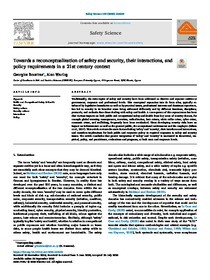Towards a reconceptualization of safety and security, their interactions, and policy requirements in a 21st century context

Boustras, Georgios ; Waring, Alan
2020
132
December
1-14
occupational safety ; security ; terrorism ; social exclusion
Occupational safety and health
https://doi.org/10.1016/j.ssci.2020.104942
English
Bibliogr.
"Traditionally, the twin topics of safety and security have been addressed as discrete and separate entities at government, corporate and professional levels. This conceptual separation into de facto silos, typically reinforced by legislative boundaries as well as by practical issues, professional interests and dominant experience, has led to security in its broadest sense being addressed differently and by different functions, disciplines, protocols, and outlooks than those dealing with safety and health. A consequence of this separateness has been that various impacts on both public and occupational safety-and-health from key areas of security threats, for example global warming consequences, terrorism, radicalization, hate crimes, white collar crime, cyber-crime, economic crime, and trafficking, frequently have been overlooked. These developing security risks have an impact on infrastructure as well as the general public, the occupational environment and the employee (Nilsen et al., 2017). This article reviews the main factors linking ‘safety' and ‘security', their interfaces and interactions, and considers implications for both public and corporate policy in required responses to safety and security issues. The article concludes that greater integration of ‘safety' and ‘security' is warranted in theoretical, empirical, policy, and practitioner, evaluations and programs, at both state and corporate levels."
Digital
The ETUI is co-funded by the European Union. Views and opinions expressed are however those of the author(s) only and do not necessarily reflect those of the European Union or the ETUI.